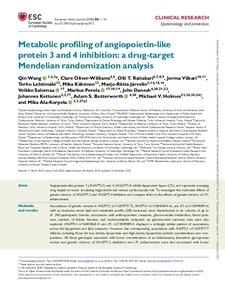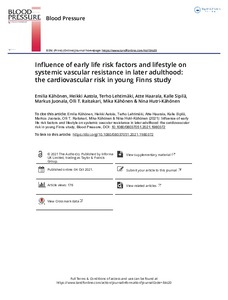Hae
Aineistot 11-20 / 33
Childhood and Adulthood Passive Smoking and Nonalcoholic Fatty Liver in Midlife: A 31-year Cohort Study
INTRODUCTION: Identifying early life risk factors remains key to the prevention of nonalcoholic fatty liver (hereinafter "fatty liver") in adulthood. However, the longitudinal association of childhood passive smoking with ...
IDO activity forecasts obesity in males and premenopausal females in a 10-year follow-up study:The Cardiovascular Risk in Young Finns Study
<p>Background and aims: Indoleamine 2,3-dioxygenase (IDO) is an intracellular enzyme associated with artery wall inflammation. Previous studies have verified correlation between IDO activity and early signs of atherosclerosis especially in females. We aimed to elucidate the relationship between an estimate of IDO activity and atherosclerotic risk factors related to non-alchohol-fatty liver (NAFLD) in a 6- and 10-year follow-up.<br></p><p>Methods: Estimates of IDO activity along with complete risk factor data were measured from females (n = 506; age 24-39) and males (n = 421; age 24-39) in 2001. Risk factor measurements were conducted again in 2007 and 2011. Statistical examinations were carried out by Pearson correlation and risk ratio analysis.<br></p><p>Results: In females, age-adjusted IDO correlated with body mass index (BMI) (p = 0.0008), waist (p = 0.0009), C reactive protein (CRP) (p = 0.0014) and logarithmically modified triglycerides (p = 0.0488) in 2007. Correlation remained significant with BMI (p = 0.0007) and waist (p = 0.0063) in 2011. In males, age-adjusted IDO correlated with waist (p = 0.0367) and high-density lipoprotein cholesterol (HDL-C) (p = 0.0489) in 2007. Correlation remained significant with HDL-C (p = 0.0348) in 2011. In risk ratio analysis, relationship between IDO and obesity was confirmed in females after 10 years (RR = 1.026, p = 0.0147, 95% CI) and in males after 6 and 10 years (RR = 1.019, p = 0.0091, 95% CI and RR = 1.015, p = 0.0404, 95% CI, respectively) when the data was adjusted for age and BMI.Conclusions: IDO activity correlated with obesity and factors related to NAFLD, namely obesity of visceral type, hypertriglyceridemia and CRP (in females), well-characterized risk factors for diabetes and atherosclerosis in 6 and 10-year follow-up in males and premenopausal females.</p>...
Association of lifetime blood pressure with adulthood exercise blood pressure response: the cardiovascular risk in young Finns study
<p>Purpose<br></p><p>Elevated blood pressure (BP) in childhood has been associated with increased adulthood BP. However, BP and its change from childhood to adulthood and the risk of exaggerated adulthood exercise BP ...
Genetic differential susceptibility to the parent-child relationship quality and the life span development of compassion
The development of compassion for others might be influenced by the social experiences made during childhood and has a genetic component. No research has yet investigated whether the parent-child relationship quality ...
Metabolic profiling of angiopoietin-like protein 3 and 4 inhibition: a drug-target Mendelian randomization analysis
<p><strong>Aims:</strong> Angiopoietin-like protein 3 (ANGPTL3) and 4 (ANGPTL4) inhibit lipoprotein lipase (LPL) and represent emerging drug targets to lower circulating triglycerides and reduce cardiovascular risk. To ...
Metabolic trajectories in childhood and adolescence: Effects on risk for schizophrenia
<p>Abnormal glucose and lipid metabolism is common in antipsychotic-naive first-episode patients with schizophrenia, but it is unclear whether these changes can already be seen in premorbid or prodromal period, before the first psychotic episode. We examined insulin, total cholesterol, low-density lipoprotein (LDL) cholesterol, high-density lipoprotein (HDL) cholesterol, and triglyceride trajectories in children and adolescents (9-18 years old), who were later diagnosed with schizophrenia, any non-affective psychosis (NAP) or affective disorder (AD). The study population consisted of a general population-based cohort "The Cardiovascular Risk in Young Finns Study", started in 1980 (n=3596). Psychiatric diagnoses were derived from the Health Care Register up to the year 2018. Multivariate statistical analysis indicated no significant differences in insulin or lipid levels in children and adolescents who later developed schizophrenia (n=41) compared to the cohort control group (n=3202). In addition, no changes in these parameters were seen in the NAP (n=74) or AD (n=156) groups compared to the controls, but lower triglyceride levels in childhood/adolescence associated with earlier diagnosis of psychotic disorder in the NAP group. Taken together, our results do not support any gross-level insulin or lipid changes during childhood and adolescence in individuals with later diagnosis of schizophrenia-spectrum disorder. Since changes in glucose and lipid metabolism can be observed in neuroleptic-naive patients with schizophrenia, we hypothesize that the more marked metabolic changes develop during the prodrome closer to the onset of the first psychotic episode. The findings have relevance for studies on developmental hypotheses of schizophrenia.</p>...
Associations of parental physical activity trajectories with offspring's physical activity patterns from childhood to middle adulthood: The Young Finns Study
We investigated the association of parental physical activity (PA) trajectories with offspring's youth and adult PA. Self-reported PA data were extracted from the Young Finns Study with three follow-ups for parents between ...
The Role of Inflammatory Cytokines as Intermediates in the Pathway from Increased Adiposity to Disease
<p>Objective <br></p><p>This study aimed to investigate the role of cytokines as intermediates in the pathway from increased adiposity to disease.<br></p><p>Methods <br></p><p>BMI and circulating levels of up to 41 cytokines ...
Influence of early life risk factors and lifestyle on systemic vascular resistance in later adulthood: the cardiovascular risk in young Finns study
<p>Purpose <br></p><p>There are limited data available concerning the effects of lifetime risk factors and lifestyle on systemic hemodynamics, especially on systemic vascular resistance. The purpose of the study was to evaluate how lifetime cardiovascular risk factors (body mass index (BMI), high-density lipoprotein, low-density lipoprotein, triglycerides, systolic blood pressure, blood glucose) and lifestyle factors (vegetable consumption, fruit consumption, smoking and physical activity) predict systemic vascular resistance index (SVRI) and cardiac index (CI) assessed in adulthood. <br></p><p>Materials and Methods <br></p><p>Our study cohort comprised 1635 subjects of the Cardiovascular Risk in Young Finns Study followed up for 27 years since baseline (1980; aged 3-18 years, females 54.3%) who had risk factor and lifestyle data available since childhood. Systemic hemodynamics were measured in 2007 (aged 30-45 years) by whole-body impedance cardiography. <br></p><p>Results <br></p><p>In the multivariable regression analysis, independent predictors of the adulthood SVRI were childhood BMI, blood glucose, vegetable consumption, smoking, and physical activity (p <= .046 for all). Vegetable consumption, smoking, and physical activity remained significant when adjusted for corresponding adult data (p <= .036 for all). For the CI, independent predictors in childhood were BMI, systolic blood pressure, vegetable consumption, and physical activity (p <= .044 for all), and the findings remained significant after adjusting for corresponding adult data (p <= .046 for all). The number of childhood and adulthood risk factors and unfavourable lifestyle factors was directly associated with the SVRI (p < .001) in adulthood. A reduction in the number of risk factors and unfavourable lifestyle factors or a favourable change in BMI status from childhood to adulthood was associated with a lower SVRI in adulthood (p < .001). <br></p><p>Conclusion <br></p><p>Childhood BMI, blood glucose, vegetable consumption, smoking and physical activity independently predict systemic vascular resistance in adulthood. A favourable change in the number of risk factors or BMI from childhood to adulthood was associated with lower vascular resistance in adulthood.<br></p>...









